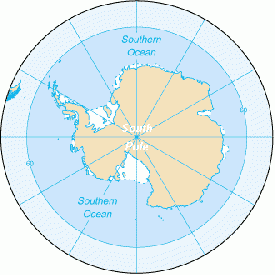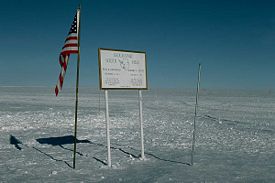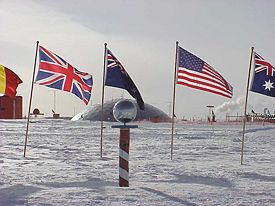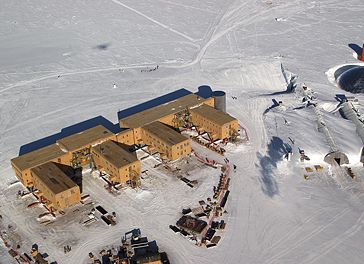Difference between revisions of "South Pole" - New World Encyclopedia
Keisuke Noda (talk | contribs) (import from wiki) |
MaedaMartha (talk | contribs) |
||
| Line 230: | Line 230: | ||
*[[North Pole]] | *[[North Pole]] | ||
*[[Chilean Antarctic Territory]] | *[[Chilean Antarctic Territory]] | ||
| + | |||
| + | ==Notes== | ||
| + | <references/> | ||
==References== | ==References== | ||
| − | + | *Allen-Heuberger, Renate Van. 1995. ''Atmospheric thermal radiation over the South Pole''. Zürcher geographische Schriften, Heft 61. Zürich: Geographisches Institut ETH. ISBN: 3906148092 9783906148090 | |
| + | *Andrew, Margaret. 2004. ''Antarctica: the unfolding story''. [Auckland, N.Z.]: Waiatarua Pub. ISBN: 1869631900 9781869631901 | ||
| + | *Avery, Tom. 2005. ''Pole dance: the story of the record-breaking British expedition to the bottom of the world''. London: Orion. ISBN: 0752864998 9780752864990 | ||
| + | *Nielsen, Jerri, and Maryanne Vollers. 2001. ''Ice bound: a doctor's incredible battle for survival at the South Pole''. New York: Talk Miramax Books/Hyperion. ISBN: 0786866845 9780786866847 | ||
==External links== | ==External links== | ||
| Line 238: | Line 244: | ||
* [http://www.cmdl.noaa.gov/obop/spo/livecamera.html NOAA South Pole Webcam] | * [http://www.cmdl.noaa.gov/obop/spo/livecamera.html NOAA South Pole Webcam] | ||
* [http://astro.uchicago.edu/cara/vtour/pole/ Virtual tour of the South Pole] | * [http://astro.uchicago.edu/cara/vtour/pole/ Virtual tour of the South Pole] | ||
| − | |||
* [http://www.cmdl.noaa.gov/gallery/SPO South Pole Photo Gallery] | * [http://www.cmdl.noaa.gov/gallery/SPO South Pole Photo Gallery] | ||
* [http://www.wunderground.com/global/stations/89009.html Current weather conditions at the South Pole (Amundsen-Scott Station)] | * [http://www.wunderground.com/global/stations/89009.html Current weather conditions at the South Pole (Amundsen-Scott Station)] | ||
Revision as of 17:01, 19 August 2007
- For other uses, see South Pole (disambiguation).
The South Pole, also known as the Geographic South Pole or Terrestrial South Pole, is the southernmost point on the surface of the Earth, on the opposite side of the Earth from the North Pole. It is the site of the US Amundsen-Scott South Pole Station, which was established in 1956 and has been permanently staffed since that date.
Geography
The Geographic South Pole is defined for most purposes as one of two points where the earth's axis of rotation intersects its surface (the other being the Geographic North Pole). However, the earth's axis of rotation is actually subject to very small "wobbles," so this definition is not adequate for very precise work; see Geographic North Pole for further information. The projection of the Geographic South Pole onto the celestial sphere gives the south celestial pole.
The coordinates of the South Pole are usually given simply as 90°S, since its longitude is geometrically undefined and irrelevant. When a longitude is desired, it may be given as 0°W.
The South Pole is located on the continent of Antarctica (although this has not been the case for all of Earth's history because of continental drift). It sits atop a featureless windswept icy plateau at an altitude of 2,835 meters (9,306 feet), about 800 miles from the nearest sea at McMurdo Sound. The ice is estimated to be about 2,700 meters (9,000 feet) thick at the Pole, so the land surface is actually near sea level.[1]
The polar ice sheet is moving at a rate of roughly 10 meters per year, so the exact position of the Pole, relative to the ice surface and the buildings constructed on it, gradually shifts over time.
The Geographic South Pole is marked by a small sign, and a stake, which are repositioned each year on New Year’s Day to compensate for the movement of the ice. The sign records the respective dates that Roald Amundsen and Robert F. Scott reached the Pole followed by a short quotation from each man, and gives the elevation as 9,301 ft.
Ceremonial South Pole
The Ceremonial South Pole is an area set aside for photo opportunities at the South Pole Station. It is located a short distance from the Geographic South Pole, and consists of a metallic sphere on a plinth, surrounded by the flags of the Antarctic Treaty signatories.
The ceremonial marker is not moved each year, so its position relative to the Geographical South Pole slowly changes over time as it drifts with the ice.
Exploration
- See also: History of Antarctica, List of Antarctica expeditions and Polar exploration.
The first humans to reach the Geographic South Pole were Norwegian Roald Amundsen and his party on December 14, 1911. Amundsen named his camp Polheim and the entire plateau surrounding the Pole Haakon VII's Vidde in honour of King Haakon VII of Norway. Amundsen's competitor Robert Falcon Scott reached the Pole a month later. On the return trip Scott and his four companions all died of starvation and extreme cold. In 1914 British explorer Ernest Shackleton's Imperial Trans-Antarctic Expedition set out with the goal of crossing Antarctica via the South Pole, but the Endurance was frozen in pack-ice and sank 11 months later.
US Admiral Richard Byrd, with the assistance of his first pilot Bernt Balchen, became the first person to fly over the South Pole on November 29, 1929. However, it was not until 31st October 1956 that men once again set foot at the Pole, when a party led by Admiral George Dufek of the US Navy landed there in a R4D Skytrain (Douglas DC-3) aircraft. The US Amundsen-Scott South Pole Station was established by air over 1956–1957 for the International Geophysical Year, and has been continuously staffed since then by research and support personnel.
After Amundsen and Scott, the next people to reach the South Pole overland (albeit with some air support) were Edmund Hillary (4th Jan 1958) and Vivian Fuchs (19th Jan 1958), and their respective parties, during the Commonwealth Trans-Antarctic Expedition. There have been many subsequent expeditions to arrive at the South Pole by surface transportation, including those by Havola, Crary and Fiennes.
On December 30 1989, Arved Fuchs and Reinhold Messner were the first to reach the South pole without animal or motorised help, using only skis and the help of wind.
The fastest unsupported walking journey to the Geographic South Pole from the ocean is 47 days and was set in 1999 by explorers Tim Jarvis and Peter Treseder, who manhauled 200 kg sleds containing food and cooking fuel.
Territorial claims
- See Antarctic territorial claims and Antarctica – Politics.
Climate
- See also Climate of Antarctica.
During the southern winter the South Pole receives no sunlight at all, and in summer the sun, though continuously above the horizon, is always low in the sky. Much of the sunlight that does reach the surface is reflected by the white snow. This lack of warmth from the sun, combined with the high altitude (about 2,800 meters), means that the South Pole has one of the coldest climates on earth. Temperatures at the South Pole are much lower than at the North Pole, primarily because the South Pole is located at altitude in the middle of a continental land mass, while the North Pole is at sea level in the middle of an ocean (which acts as a reservoir of heat).
In midsummer, as the sun reaches its maximum elevation of about 23.5 degrees, temperatures at the South Pole average around −25°C (−12°F). As the six-month "day" wears on and the sun gets lower, temperatures drop as well, with temperatures around sunset (late March) and sunrise (late September) being about −45°C (−49°F). In winter, the temperature remains steady at around −65°C (−85°F). The highest temperature ever recorded at the Amundsen-Scott South Pole Station is −13.6°C (7.5°F), and the lowest is −82.8°C (−117.0°F)[2] (however, this is not the lowest recorded anywhere on earth, that being −89.6°C (−129.28°F) at Vostok Station).
The South Pole has a desert climate, almost never receiving any precipitation. Air humidity is near zero. However, high winds can cause the blowing of snowfall, and the accumulation of snow amounts to about 20 cm per year.[3] The dome seen in the pictures is partially buried due to snow storms, and the entrance to the dome has to be regularly bulldozed to uncover it. More recent buildings are raised on stilts so that the snow does not build up against the side of them.
Average monthly temperatures and precipitation (Celsius, millimetres) at the South Pole, Antarctica
| Month | Jan | Feb | Mar | Apr | May | Jun | Jul | Aug | Sep | Oct | Nov | Dec | Year |
|---|---|---|---|---|---|---|---|---|---|---|---|---|---|
| Avg high °C | −25 | −37 | −50 | −52 | −53 | −55 | −55 | −55 | −55 | −47 | −36 | −26 | −45 |
| Avg low °C | −28 | −42 | −56 | −60 | −61 | −61 | −63 | −62 | −62 | −53 | −39 | −28 | −51 |
| Precipitation millimeters | — | — | — | — | — | — | — | — | — | — | — | — | 2.5 |
Average monthly temperatures and precipitation (Fahrenheit, inches) at the South Pole, Antarctica
| Month | Jan | Feb | Mar | Apr | May | Jun | Jul | Aug | Sep | Oct | Nov | Dec | Year |
|---|---|---|---|---|---|---|---|---|---|---|---|---|---|
| Avg high °F | −14 | −35 | −58 | −63 | −64 | −65 | −68 | −68 | −67 | −54 | −33 | −15 | −50 |
| Avg low °F | −20 | −44 | −70 | −76 | −78 | −79 | −82 | −81 | −81 | −64 | −39 | −20 | −61 |
| Precipitation inches | — | — | — | — | — | — | — | — | — | — | — | — | 0.1 |
Source: weatherbase.com
Time
In most places on Earth local time is more-or-less synchronised to the position of the sun in the sky. This fails at the South Pole which has "days" lasting for a whole year. There is no a priori reason for placing the South Pole in any particular time zone, but as a matter of practical convenience the Amundsen-Scott South Pole Station keeps New Zealand time. This is because the US flies its resupply missions ("Operation Deep Freeze") out of Christchurch, New Zealand.
Flora and fauna
Due to its exceptionally harsh climate, there are no native resident plants or animals at the South Pole. Remarkably, though, off-course skuas are occasionally seen there.[4]
In 2000 it was reported that microbes had been detected living in the South Pole ice, though scientists think it unlikely that they evolved in Antarctica.[5]
See also
- Antarctica
- List of Antarctica expeditions
- North Pole
- Chilean Antarctic Territory
Notes
- ↑ Amundsen-Scott South Pole Station, National Science Foundation, Office of Polar Programs
- ↑ Your stay at Amundsen-Scott South Pole Station, National Science Foundation Office of Polar Programs
- ↑ Initial environmental evaluation – development of blue-ice and compacted-snow runways, National Science Foundation Office of Polar Programs, April 9, 1993
- ↑ "Non-human life form seen at Pole", The Antarctic Sun
- ↑ "Snow microbes found at South Pole", BBC News, 10 July, 2000
ReferencesISBN links support NWE through referral fees
- Allen-Heuberger, Renate Van. 1995. Atmospheric thermal radiation over the South Pole. Zürcher geographische Schriften, Heft 61. Zürich: Geographisches Institut ETH. ISBN: 3906148092 9783906148090
- Andrew, Margaret. 2004. Antarctica: the unfolding story. [Auckland, N.Z.]: Waiatarua Pub. ISBN: 1869631900 9781869631901
- Avery, Tom. 2005. Pole dance: the story of the record-breaking British expedition to the bottom of the world. London: Orion. ISBN: 0752864998 9780752864990
- Nielsen, Jerri, and Maryanne Vollers. 2001. Ice bound: a doctor's incredible battle for survival at the South Pole. New York: Talk Miramax Books/Hyperion. ISBN: 0786866845 9780786866847
External links
- South Pole Station info on 70South
- NOAA South Pole Webcam
- Virtual tour of the South Pole
- South Pole Photo Gallery
- Current weather conditions at the South Pole (Amundsen-Scott Station)
- "A south pole adventure" - blog of a scientist at the station
- Poles by the Australian Antarctic Division
- iceman's South Pole page
- Big Dead Place
- UK team makes polar trek history - BBC News article on first expedition to Pole of Inaccessibility without mechanical assistance
be-x-old:Паўднёвы полюс fy:Súdpoal kn:ದಕ್ಷಿಣ ಧ್ರುವ ru-sib:Полуденной Плюс ur:قطب جنوبی
Credits
New World Encyclopedia writers and editors rewrote and completed the Wikipedia article in accordance with New World Encyclopedia standards. This article abides by terms of the Creative Commons CC-by-sa 3.0 License (CC-by-sa), which may be used and disseminated with proper attribution. Credit is due under the terms of this license that can reference both the New World Encyclopedia contributors and the selfless volunteer contributors of the Wikimedia Foundation. To cite this article click here for a list of acceptable citing formats.The history of earlier contributions by wikipedians is accessible to researchers here:
The history of this article since it was imported to New World Encyclopedia:
Note: Some restrictions may apply to use of individual images which are separately licensed.



